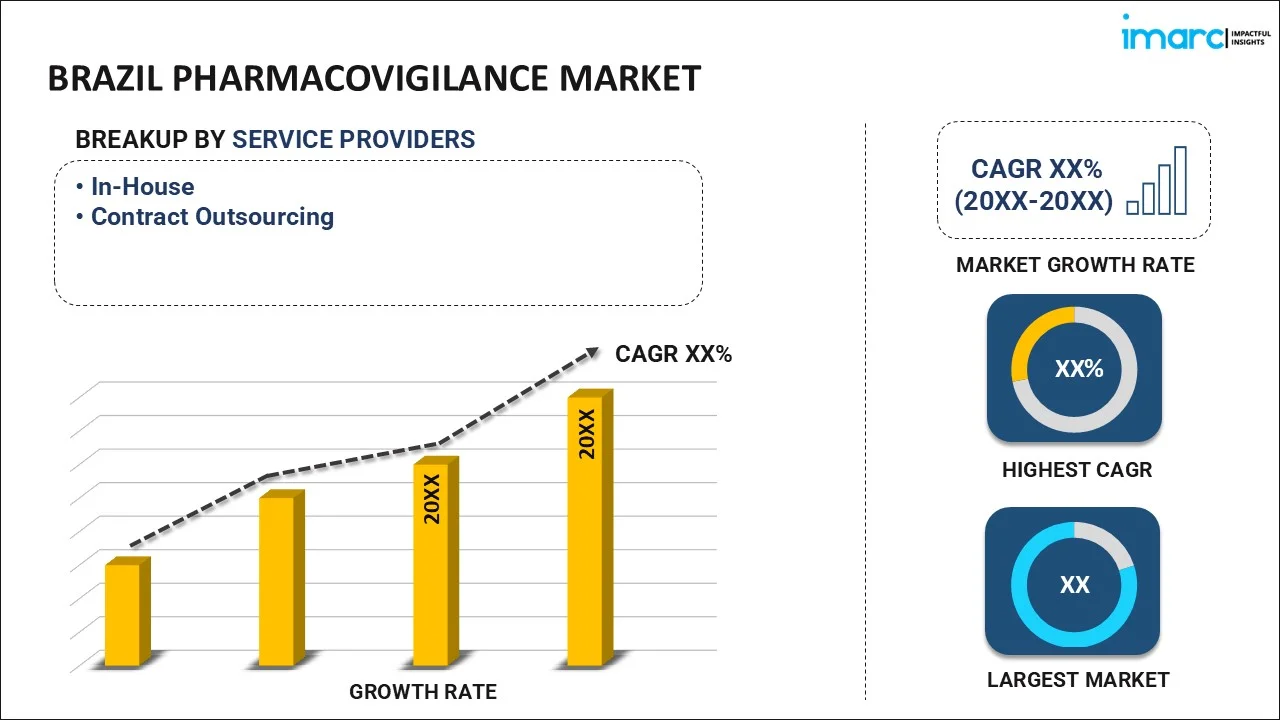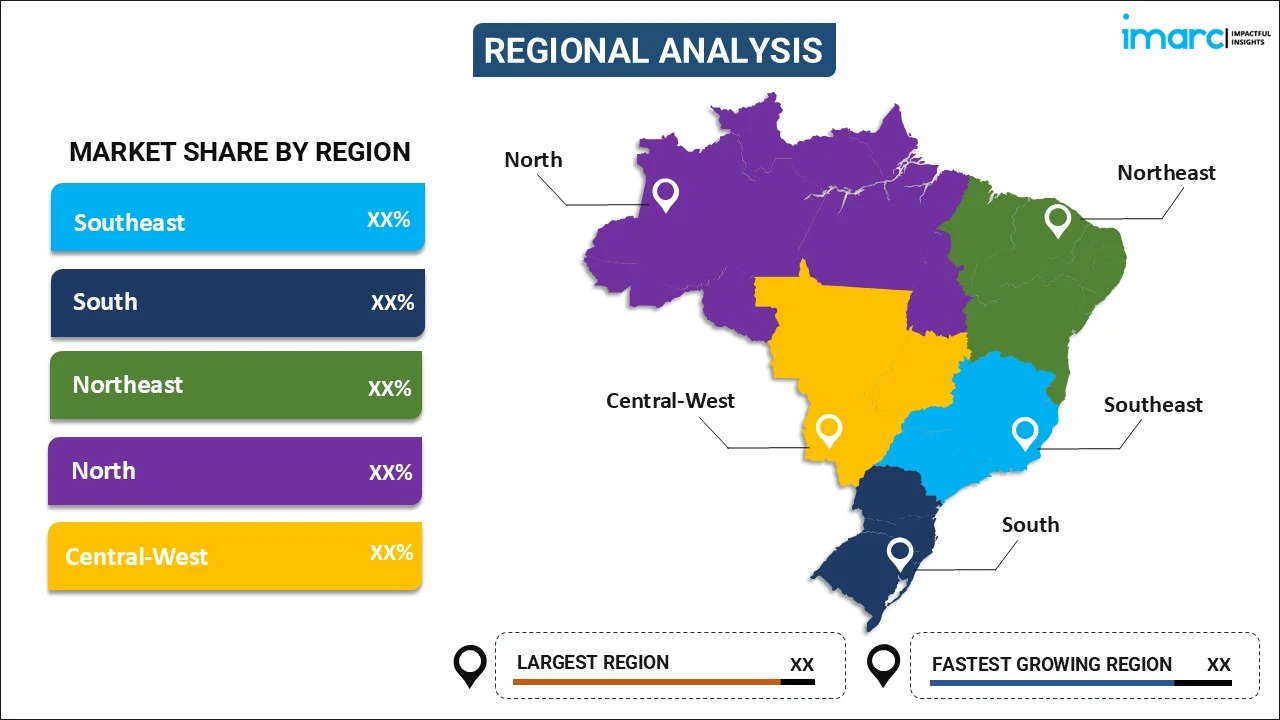
Brazil Pharmacovigilance Market Size, Share, Trends and Forecast by Service Provider, Product Life Cycle, Type, Process Flow, Therapeutic Area, End Use, and Region, 2026-2034
Brazil Pharmacovigilance Market Overview:
The Brazil pharmacovigilance market size reached USD 167.1 Million in 2025. Looking forward, IMARC Group expects the market to reach USD 285.6 Million by 2034, exhibiting a growth rate (CAGR) of 6.14% during 2026-2034. The market is primarily driven by the rise in the regulatory oversight, the widespread adoption of advanced technologies, such as artificial intelligence (AI) and Big Data, considerable growth in the adoption of outsourced services, and the rising demand for enhanced drug safety monitoring and operational efficiency in a shifting environment.
|
Report Attribute
|
Key Statistics
|
|---|---|
|
Base Year
|
2025 |
|
Forecast Years
|
2026-2034
|
|
Historical Years
|
2020-2025
|
| Market Size in 2025 | USD 167.1 Million |
| Market Forecast in 2034 | USD 285.6 Million |
| Market Growth Rate (2026-2034) | 6.14% |
Brazil Pharmacovigilance Market Trends:
Increased Regulatory Scrutiny and Compliance
Increased regulatory scrutiny in the Brazilian pharmacovigilance sector is rising as authorities place greater emphasis on drug safety and patient welfare. The National Health Surveillance Agency (ANVISA) has implemented strict regulatory measures to monitor adverse drug reactions (ADRs) and guarantee adherence to international standards. For instance, in March 2024, Brazil's ANVISA approved Normative Ruling No. 289/2024 to streamline registration for medicines, vaccines, and APIs, improving market access. This regulation follows a consultation process and emphasizes rigorous safety and efficacy documentation. This adjustment requires pharmaceutical companies to significantly enhance their pharmacovigilance systems and reporting procedures. Using data analysis and digital tools is essential for meeting regulatory requirements accurately and efficiently. As a result, companies are making significant investments in strong pharmacovigilance systems in order to adhere to changing regulations, manage risks, and safeguard the well-being of patients. As Brazil increasingly follows global pharmacovigilance standards, the need for services that monitor drug safety and ensure adherence is rising. This, in turn, is resulting in an enhanced emphasis on the need for advanced pharmacovigilance solutions and driving market expansion.
Rapid Adoption of Advanced Technologies
The increasing use of new pharmacovigilance technologies is becoming an important trend in the market in Brazil. Businesses are using artificial intelligence (AI), machine learning (ML), and big data analysis to improve the real-time identification, evaluation, and reporting of negative effects caused by drugs. For instance, in December 2024, the Brazilian Senate approved Bill No. 2,338/2023 to regulate AI development, usage, and governance, emphasizing responsible innovation and safety. These advancements allow for quicker handling of large quantities of data, enhancing the precision and effectiveness of pharmacovigilance tasks. Automated reporting systems and AI-powered safety monitoring are assisting pharmaceutical companies in proactively identifying safety concerns, minimizing manual mistakes, and maintaining regulatory adherence. Continuous technological progress enables real-time monitoring of drug safety, leading to faster responses to adverse events and reduced risks. The increasing utilization of these technologies is impacting the development of pharmacovigilance procedures in Brazil, further leading to improved drug safety supervision and risk reduction within the sector.
Expansion of Outsourced Pharmacovigilance Services
The growth of outsourced pharmacovigilance services in Brazil is being significantly fueled by the rising complexity of pharmacovigilance regulations and the need for specialized expertise. With regulatory requirements getting tougher, smaller, and mid-sized pharmaceutical companies are turning more to third-party providers for help with drug safety monitoring and reporting duties. Outsourcing enables these companies to utilize advanced technology such as data analytics and automation tools, which improve the pharmacovigilance process. For instance, according to industry reports, Brazil's IT outsourcing market is growing, driven by a skilled workforce, competitive pricing, and an expanding technology ecosystem. The international data corporation (IDC) predicts a 5.95% annual growth, reaching $8.09 billion by 2028. This approach decreases internal tasks and guarantees cost efficiency in handling complicated regulatory duties. External providers typically possess the essential expertise to navigate the evolving regulatory landscape in Brazil, particularly in complying with the standards of ANVISA. Businesses are continuously expanding their market by outsourcing their pharmacovigilance systems and concentrating on their core business operations.
Brazil Pharmacovigilance Market Segmentation:
IMARC Group provides an analysis of the key trends in each segment of the market, along with forecasts at the region/country level for 2026-2034. Our report has categorized the market based on service provider, product life cycle, type, process flow, therapeutic area, and end use.
Service Provider Insights:

- In-House
- Contract Outsourcing
The report has provided a detailed breakup and analysis of the market based on the service provider. This includes in-house and contract outsourcing.
Product Life Cycle Insights:
- Pre-clinical
- Phase I
- Phase II
- Phase III
- Phase IV
A detailed breakup and analysis of the market based on the product life cycle have also been provided in the report. This includes pre-clinical, phase I, phase II, phase III, and phase IV.
Type Insights:
- Spontaneous Reporting
- Intensified ADR Reporting
- Targeted Spontaneous Reporting
- Cohort Event Monitoring
- EHR Mining
A detailed breakup and analysis of the market based on the type have also been provided in the report. This includes Spontaneous Reporting, Intensified ADR Reporting, Targeted Spontaneous Reporting, Cohort Event Monitoring, and EHR Mining.
Process Flow Insights:
- Case Data Management
- Case Logging
- Case Data Analysis
- Medical Reviewing and Reporting
- Signal Detection
- Adverse Event Logging
- Adverse Event Analysis
- Adverse Event Review and Reporting
- Risk Management System
- Risk Evaluation System
- Risk Mitigation System
A detailed breakup and analysis of the market based on the process flow have also been provided in the report. This includes case data management (case logging, case data analysis, medical reviewing and reporting), signal detection (adverse event logging, adverse event analysis, adverse event review and reporting), and risk management system(risk evaluation system, risk mitigation system).
Therapeutic Area Insights:
- Oncology
- Neurology
- Cardiology
- Respiratory System
- Others
A detailed breakup and analysis of the market based on the therapeutic area have also been provided in the report. This includes Oncology, Neurology, Cardiology, Respiratory System, and others.
End Use Insights:
- Pharmaceutical Companies
- Bio Technology Companies
- Medical Device Companies
- Others
A detailed breakup and analysis of the market based on the end use have also been provided in the report. This includes pharmaceutical companies, bio technology companies, medical device companies, and others.
Regional Insights:

- Southeast
- South
- Northeast
- North
- Central-West
The report has also provided a comprehensive analysis of all the major regional markets, which include Southeast, South, Northeast, North, and Central-West.
Competitive Landscape:
The market research report has also provided a comprehensive analysis of the competitive landscape. Competitive analysis such as market structure, key player positioning, top winning strategies, competitive dashboard, and company evaluation quadrant has been covered in the report. Also, detailed profiles of all major companies have been provided.
Brazil Pharmacovigilance Market Report Coverage:
| Report Features | Details |
|---|---|
| Base Year of the Analysis | 2025 |
| Historical Period | 2020-2025 |
| Forecast Period | 2026-2034 |
| Units | Million USD |
| Scope of the Report |
Exploration of Historical Trends and Market Outlook, Industry Catalysts and Challenges, Segment-Wise Historical and Future Market Assessment:
|
| Service Providers Covered | In-House, Contract Outsourcing |
| Product Life Cycles Covered | Pre-clinical, Phase I, Phase II, Phase III, Phase IV |
| Types Covered | Spontaneous Reporting, Intensified ADR Reporting, Targeted Spontaneous Reporting, Cohort Event Monitoring, EHR Mining |
| Process Flows Covered |
|
| Therapeutic Areas Covered | Oncology, Neurology, Cardiology, Respiratory System, Others. |
| End Uses Covered | Pharmaceutical Companies, Bio Technology Companies, Medical Device Companies, Others |
| Regions Covered | Southeast, South, Northeast, North, and Central-West. |
| Customization Scope | 10% Free Customization |
| Post-Sale Analyst Support | 10-12 Weeks |
| Delivery Format | PDF and Excel through Email (We can also provide the editable version of the report in PPT/Word format on special request) |
Key Questions Answered in This Report:
- How has the Brazil pharmacovigilance market performed so far and how will it perform in the coming years?
- What is the breakup of the Brazil pharmacovigilance market on the basis of service provider?
- What is the breakup of the Brazil pharmacovigilance market on the basis of product life cycle?
- What is the breakup of the Brazil pharmacovigilance market on the basis of type?
- What is the breakup of the Brazil pharmacovigilance market on the basis of process flow?
- What is the breakup of the Brazil pharmacovigilance market on the basis of therapeutic area?
- What is the breakup of the Brazil pharmacovigilance market on the basis of end use?
- What is the breakup of the Brazil pharmacovigilance market on the basis of region?
- What are the various stages in the value chain of the Brazil pharmacovigilance market?
- What are the key driving factors and challenges in the Brazil pharmacovigilance?
- What is the structure of the Brazil pharmacovigilance market and who are the key players?
- What is the degree of competition in the Brazil pharmacovigilance market?
Key Benefits for Stakeholders:
- IMARC’s industry report offers a comprehensive quantitative analysis of various market segments, historical and current market trends, market forecasts, and dynamics of the Brazil pharmacovigilance market from 2020-2034.
- The research report provides the latest information on the market drivers, challenges, and opportunities in the Brazil pharmacovigilance market.
- Porter's five forces analysis assist stakeholders in assessing the impact of new entrants, competitive rivalry, supplier power, buyer power, and the threat of substitution. It helps stakeholders to analyze the level of competition within the Brazil pharmacovigilance industry and its attractiveness.
- Competitive landscape allows stakeholders to understand their competitive environment and provides an insight into the current positions of key players in the market.
Need more help?
- Speak to our experienced analysts for insights on the current market scenarios.
- Include additional segments and countries to customize the report as per your requirement.
- Gain an unparalleled competitive advantage in your domain by understanding how to utilize the report and positively impacting your operations and revenue.
- For further assistance, please connect with our analysts.
 Request Customization
Request Customization
 Speak to an Analyst
Speak to an Analyst
 Request Brochure
Request Brochure
 Inquire Before Buying
Inquire Before Buying




.webp)




.webp)












